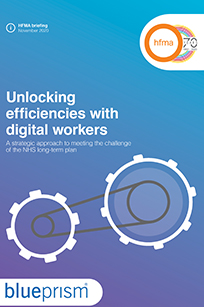A new workforce
As the pandemic, we all hope, recedes and normal NHS service is resumed, the language of cost improvement, waste reduction, unwarranted variation and efficient theatres will return. After years of productivity and efficiency gains, the service will feel that it has grasped most of the biggest opportunities, but – as noted in the recent HFMA roundtable – automation and artificial intelligence (AI) could open new avenues to improve efficiency and quality, including NHS finance. 
The NHS in England has a strategy, as part of its long-term plan, that aims to make the service a world leader in AI and machine learning. The thrust of the strategy is the use of software to free up staff time across the NHS, at the frontline and in support services.
AI refers to software that can emulate, to some extent, human reasoning or analysis – for example, the algorithm used by TV streaming services to suggest shows or films you might like based on your previous viewing.
Automation, or robotic process automation, refers to the ability of computer programmes to perform enormous amounts of repetitive tasks accurately.
Automation gurus see the software as a workforce of software robots who never get tired and can repeat monotonous tasks with a high degree of accuracy every time. Trusts are, for example, using automation software to cancel appointments when requested by patients, and notify the clinic of a free appointment slot that can be reallocated.
Not only is this a better use of clinical time, but also delivers significant savings to providers. Automation and AI can be combined to analyse a lot of tests quickly, and produce accurate diagnoses.
Finance departments in some trusts are making strides in automation and AI. East Lancashire Hospitals NHS Trust’s automation of its finance processes led to it winning the HFMA Embracing Technology Award 2020. Not only do its systems pull the latest figures from a master database into files automatically, but software also helps analyse thousands of lines of costs.
The work was prompted by a familiar requirement. Finance departments must be as efficient as possible, but they tend to accumulate tasks that do not add value, says Darrell Tobin (pictured below), the Lancashire trust’s costing consultant, who has masterminded much of its automation work.
Technology and computing offer a way of addressing this, but the NHS does not use these tools as much as it could, and certainly not as much as the private sector, he adds.
The trust has automated some of its analysis work through its Fast (Forecast Analysis Statistical Tool) software.
Focus areas
One of the first areas Mr Tobin looked at was the month-end process and the comparison of costs at each cost centre. ‘We look for unusual movement – for example, where spending is up by more than 50%, or dropped by a significant amount. And then we see if that is acceptable or unacceptable. Historically, we have been checking every line manually, and this was something we could automate,’ he says.
‘In addition, using their own personal knowledge, staff were checking certain cost centre items because they had seen movements in the past. That was not particularly efficient – they were checking 90% of the codes every month, when they hadn’t moved up or down by 10% or less.’
The trust used standard deviation to come up with statistical measures of movement. This assessed whether a change was statistically unusual or part of a normal distribution.
Kathy Mortimer, a financial adviser at the trust, says the software highlights areas that require further investigation. Indeed, the trust says finance staff need only check 20% of line items regularly. ‘We can check if the lines highlighted are correct – was it a miscoding, for example – but overall, it reduces the workload for the finance team.’
She adds that the software has led to greater quality and accuracy. The finance team can place comments against each highlighted line, which feed back into the software’s learning database about what constitutes an adverse movement.
Mr Tobin is building a directory of common statements to be used to indicate whether a movement is acceptable or unacceptable. The availability of these comments to all appropriate members of staff gives a degree of organisational memory – ensuring the finance team can compensate for annual leave and illness, or if a member of staff moves on.
Mr Tobin adds that the team will not need to check every cost centre code each month – those with little to no significant movement could be checked quarterly or even every six months.
Because it is statistically driven, the software works well with large or small items of spending. ‘Once an item is flagged as unusual, finance colleagues can put comments in,’ Mr Tobin says. ‘When they do this, the system stores these comments and the following month – or immediately dependent upon settings – the comments are presented back, attached to the cost centre account code line item. This eliminates duplicated checks on line items.’
This access to the information, and its movement between different systems across the trust, is facilitated by a piece of automation software known as Petals or Programmable Extract Transform And Loading System. The trust has one large database from which up-to-date figures can be pulled into, for example, the Fast system, Power BI or its ledger automatically.
This means finance and procurement staff, business managers and others are working with the latest information.
‘The idea, over time, is to create a network of these databases across trusts. If you standardise and align the ledger databases and then standardise the ledger with data and metrics, you can challenge suppliers on the cost of an item to see if you are getting value for money,’ Mr Tobin says.
As the NHS recovers and renews its attention on reducing waste and unwarranted variation, he believes the system will help release significant savings, and staff time will be released and recycled.
’We will have extra time because we are not wasting it on non-value-added tasks. We will be asking what other services we can provide. People will be engaging with the business owners in the trust and adding value.’
The automated identification of cost savings was the focus of a recent pilot run by software developer Civica. It says that across the six trusts in the pilot, potential cost savings opportunities of at least 3% were found in each trust in under 24 hours.
The software, called Aurum, examines patient-level costing data to find systemic variation in clinical activity that might otherwise be missed, and found savings totalling £40m in the pilot sites.
Steve Haines, managing director for Civica Population Health Intelligence, says costing can generate huge amounts of valuable information, but it is underused.
The software focuses efforts on opportunities to drive value and identifies variations in activity at a clinician and system level – a surgeon who spends longer performing the same procedure as colleagues, or theatre capacity consistently under-used.
Software pilot
North West Anglia NHS Foundation Trust was one of those involved in the pilot. Taking 2019/20 data from Civica’s CostMaster software, which provides the trust with patient-level costing, service-line reporting and end-to-end cost management, Aurum found potential savings worth £10m.
The software identified opportunities to maximise theatre capacity, which will be increasingly important as the NHS seeks to return services to pre-Covid levels, hopefully later this year.
Joel Harrison (pictured), the chief finance officer at North West Anglia NHS Foundation Trust, says Aurum will play a critical role in supporting the trust’s long-term financial sustainability, helping to increase productivity and the overall quality of care.
The trust has used service line reporting information on a quarterly basis for several years. ‘This was analysed at a divisional and service level. However, the pilot presents us with an opportunity to look at our information and activities in a much greater level of detail,’ he adds.
‘It’s really important we use all our resources efficiently; this tool will enable us to focus resources on areas of greatest opportunity. It brings these to life and allows the teams to spend time on delving into the detail rather than trying to understand the data.’
The Aurum system has enabled the trust to identify and focus resources on the areas that appear to have the greatest opportunity for productivity or efficiency gains, and identify opportunities for variation within services and at a consultant level.
Understandably, cost improvement is not the focus for trusts as they continue to address the challenges presented by Covid-19. But Mr Harrison says the trust will benefit from the savings opportunities identified by the system.
‘Given the pandemic, we’ve had limited opportunity so far to really explore the benefits of the tool and particularly socialise it with our clinical teams,’ he says.
‘We’re looking forward to building on our initial analysis and embedding the tool into our developing transformation programme; working alongside our clinical teams and in the longer term as part of our increasing integration of services with our system, primary and community care partners.’
There is no doubting the power of automation and AI. The latter has been used at national level to aid the NHS response to Covid-19 by tracking patterns and markers of the illness.
Automation offers a relief from the monotony of some repetitive processes, but also gains from higher accuracy and faster processing. AI could help trusts dive deeper into the data, finding otherwise invisible savings opportunities.
The NHS may be fully focused on dealing with Covid, but automation and AI could be vital in its recovery.
Robot workers
Digital workers – software robots or bots – can free up staff time and can help make IT systems interoperable, according to a recent HFMA briefing with Blue Prism.
A digital workforce must be part of any organisation’s digital armoury, and automation should be backed at strategic level if it is to make an organisation-wide impact, it said.
The briefing is based on research looking at whether technology and digital developments are part of NHS boards’ strategic thinking. The research found that board papers raised technological transformation and the wider use of digital solutions, but there was little evidence of discussion on how digital strategies would be achieved, or review of metrics or key performance indicators. And, while most NHS bodies had staff digital champions, individual staff were often unaware of what the digital agenda meant for them.
The HFMA and Blue Prism, a leader in automation across the world, found examples of good practice in the NHS:
The Royal Free London NHS Foundation Trust is developing a project to use digital workers to gather usable outpatient clinic data. There is limited data about the clinics currently, partly because of the payment system, which means detailed coding is not required. Rather than adding an extra task for clinicians by asking them to record a diagnosis in the patient record, the use of digital workers is being proposed. Following clinics, letters are written to the patients and their GPs that include the diagnosis – digital workers could ‘read’ the letters and record the diagnoses.
The Royal Marsden NHS Foundation Trust is using a software robot to process agency invoices. Currently, HR staff validate invoices manually against the staff rostering system, and capture the cost centre to be added to the trust’s accounting information. In the new process, a bot will validate invoices, add the information to the accounting system and present the invoice for approval and payment by a member of staff.
Related content
We are excited to bring you a fun packed Eastern Branch Conference in 2025 over three days.
This event is for those that will benefit from an overview of costing in the NHS or those new to costing and will cover why we cost and the processes.